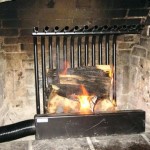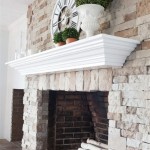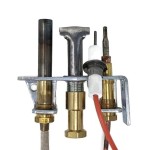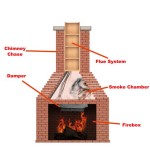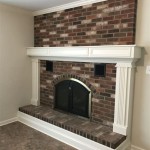Gas Fireplace Insert Trim: Enhancing Aesthetics and Functionality
Gas fireplace inserts offer an efficient and convenient way to upgrade an existing fireplace or add supplemental heat to a room. Beyond the technological advancements and heating capabilities, the aesthetics of a gas fireplace insert are significantly influenced by the trim. Gas fireplace insert trim serves not only as a decorative element but also as a crucial component for proper installation and functionality. This article explores the various aspects of gas fireplace insert trim, including its purpose, types, materials, selection considerations, and installation guidelines.
Purpose of Gas Fireplace Insert Trim
The primary purpose of gas fireplace insert trim is to bridge the gap between the insert itself and the existing fireplace opening. Fireplace openings often vary greatly in size and shape. The trim effectively covers any unsightly gaps or exposed areas, providing a clean and finished appearance. This contributes significantly to the overall aesthetic appeal of the fireplace. However, trim goes beyond mere aesthetics; it also plays a role in functionality.
From a functional perspective, trim helps to direct airflow around the insert. Proper airflow is essential for efficient heat distribution and to prevent overheating. Some trim designs incorporate vents or openings that facilitate the movement of air into and out of the fireplace cavity. Furthermore, trim can act as a barrier, preventing debris and dust from entering the space between the insert and the fireplace surround. This helps maintain cleanliness and reduces the risk of potential hazards. The trim also provides a degree of safety by covering sharp edges and potentially hot surfaces around the insert.
In essence, the trim serves a dual purpose: enhancing the visual appeal of the fireplace and contributing to its efficient, safe, and clean operation. Without appropriate trim, a gas fireplace insert may appear unfinished and may not function optimally. The selection of the correct trim is, therefore, a critical component of the overall fireplace installation process.
Types of Gas Fireplace Insert Trim
The market offers a wide variety of gas fireplace insert trim options, each designed to cater to different aesthetic preferences, fireplace sizes, and installation requirements. Understanding the different types available is crucial for making an informed selection.
Overlap Trim: This is the most common type of trim and is characterized by extending beyond the edges of the fireplace opening onto the surrounding wall. It typically consists of a flat or slightly raised frame that provides a clean and seamless transition between the insert and the wall. Overlap trim is versatile and can be used with a wide range of fireplace styles. It is also forgiving in cases where the fireplace opening is slightly irregular.
Flush-Mount Trim: As the name suggests, flush-mount trim sits flush with the surrounding wall. This creates a sleek and modern aesthetic. Installing flush-mount trim requires precise measurements and a perfectly level fireplace opening. Any imperfections in the opening will be highly visible with this type of trim. Flush-mount trim often uses magnets or other concealed fasteners for a cleaner look without visible screws or hardware.
Picture Frame Trim: This type of trim resembles a picture frame and adds a decorative element to the fireplace. It can be more ornate than overlap or flush-mount trim, featuring details such as beveled edges or decorative molding. Picture frame trim is suitable for fireplace designs where a more traditional or elaborate look is desired.
Custom Trim: For unique or challenging installations, custom trim may be necessary. Custom trim allows homeowners to achieve a specific look or to accommodate unusual fireplace dimensions. This type of trim is typically fabricated by a professional and can be made from a variety of materials to match the specific design requirements.
Adjustable Trim: Some trim options are designed with adjustable features to accommodate variations in fireplace opening sizes. These trims often have telescoping or sliding components that allow for a degree of flexibility during installation. Adjustable trim is a practical choice when precise measurements are difficult to obtain or when minor adjustments are needed to achieve a proper fit.
Materials Used in Gas Fireplace Insert Trim
The material used to construct gas fireplace insert trim significantly impacts its appearance, durability, and cost. The choice of material should be carefully considered based on the desired aesthetic, the overall style of the room, and budget constraints.
Steel: Steel is a popular choice for fireplace trim due to its strength, durability, and relatively low cost. Steel trim is typically powder-coated or painted to provide a finished look and to protect against rust and corrosion. It can be found in a variety of colors and finishes, making it a versatile option for different fireplace styles. Stainless steel is also used for trim, offering superior corrosion resistance and a modern, industrial appearance. However, stainless steel trim is generally more expensive than painted steel trim.
Aluminum: Aluminum is another lightweight and durable material often used for fireplace trim. Aluminum is highly resistant to corrosion and can be easily formed into various shapes and designs. Like steel, aluminum trim is typically powder-coated or painted to achieve the desired finish. Aluminum is a good option for homeowners looking for a low-maintenance and long-lasting trim solution.
Cast Iron: Cast iron offers a traditional and timeless aesthetic. Cast iron trim is known for its durability and can withstand high temperatures. It is often used in conjunction with traditional or antique-style fireplaces. Cast iron trim typically has a textured surface and can be painted or left with a natural finish. However, cast iron trim is typically heavier and more expensive than steel or aluminum trim.
Wood: Wood trim can be a good option for homeowners seeking a warm and natural look. Wood trim is typically used in conjunction with a surrounding mantel and can be stained or painted to match the existing decor. However, wood trim is not suitable for all fireplace installations. It is important to ensure that the wood trim is properly insulated and protected from excessive heat to prevent warping or combustion. Local building codes may restrict the use of wood trim near a gas fireplace insert.
Other Materials: In addition to the materials listed above, other materials such as stone, tile, and composite materials can be used for fireplace trim. These materials offer unique aesthetic properties and can be customized to match specific design requirements. The selection of these materials often involves a custom fabrication process.
Selection Considerations for Gas Fireplace Insert Trim
Choosing the right gas fireplace insert trim involves careful consideration of several factors, including the size of the fireplace opening, the style of the insert, the overall aesthetic of the room, and budget limitations. Failing to consider these factors may result in a trim that does not fit properly or that clashes with the existing decor.
Fireplace Opening Measurements: Accurate measurements of the fireplace opening are crucial for selecting the correct trim size. Measure the height and width of the opening at several points to ensure accurate dimensions. If the opening is irregular in shape, it may be necessary to create a template to ensure a proper fit. Consult the manufacturer's specifications for the gas fireplace insert to determine the recommended trim size for that specific model. Inaccurate measurements can lead to gaps or overlaps, compromising both the aesthetics and functionality of the trim.
Insert Style and Finish: The style and finish of the trim should complement the design of the gas fireplace insert. Consider the shape, color, and materials used in the insert when selecting the trim. For example, a modern insert with a sleek black finish may pair well with a flush-mount steel trim, while a traditional insert with a brass accent may benefit from a picture frame trim with a complementary finish. Ensure the trim color does not clash with the insert or the surrounding fireplace surround. The goal is to create a cohesive and visually appealing fireplace design.
Room Decor: The trim should also harmonize with the overall decor of the room. Consider the style, colors, and materials used in the room when selecting the trim. For example, a room with a rustic design may benefit from a cast iron or wood trim, while a room with a modern design may be better suited to a sleek steel or aluminum trim. Avoid selecting a trim that clashes with the existing furniture or wall colors. The trim should enhance the overall aesthetic of the room rather than detract from it.
Budget: The cost of gas fireplace insert trim can vary widely depending on the material, style, and size. Set a budget for the trim and consider the long-term value of different options. While inexpensive trim may seem appealing initially, it may not be as durable or aesthetically pleasing as more expensive options. Factor in the cost of installation when calculating the overall budget. Complex trim designs or custom installations may require professional assistance, adding to the overall cost. Weigh the benefits of different trim options against the budget constraints to make an informed decision.
Airflow Considerations: As mentioned earlier, trim can play a role in airflow around the insert. If the fireplace insert requires specific airflow characteristics, select a trim that facilitates proper ventilation. Some trims feature vents or openings that allow for the circulation of air around the insert. Consult the manufacturer's specifications for the gas fireplace insert to determine the recommended airflow requirements and choose a trim that meets those requirements.
Installation Guidelines for Gas Fireplace Insert Trim
Proper installation of gas fireplace insert trim is essential for ensuring both its aesthetic appeal and functional performance. Incorrect installation can lead to gaps, misalignment, or even safety hazards. While some homeowners may be comfortable installing the trim themselves, it is often recommended to hire a professional installer to ensure a proper and safe installation.
Preparation: Before beginning the installation, carefully read the manufacturer's instructions for both the gas fireplace insert and the trim. Gather all the necessary tools and materials, including a level, measuring tape, screwdriver, drill, and any required fasteners. Ensure that the fireplace opening is clean and free of any debris. Inspect the trim for any damage or defects before proceeding with the installation.
Measurement and Alignment: Accurately measure the fireplace opening and the trim to ensure a proper fit. Use a level to ensure that the trim is aligned correctly. Mark the locations for any required fasteners, such as screws or brackets. Take care to avoid damaging the surrounding wall or fireplace surround during the measurement and marking process.
Attachment: Attach the trim to the gas fireplace insert following the manufacturer's instructions. Use the appropriate fasteners to secure the trim in place. Avoid overtightening the fasteners, as this can damage the trim or the insert. If using adhesive, apply it evenly and allow it to dry completely before using the fireplace. Ensure there are no visible gaps or misalignments between the trim and the insert.
Testing: After the trim is installed, test the gas fireplace insert to ensure that it is functioning properly. Check for any leaks or unusual noises. Verify that the trim is not obstructing airflow or interfering with the operation of the insert. If any problems are detected, consult the manufacturer's instructions or contact a qualified technician.
Safety Precautions: Always follow all safety precautions when working with gas appliances. Ensure that the gas supply is turned off before attempting any repairs or modifications. Wear appropriate personal protective equipment, such as gloves and eye protection. If you are not comfortable working with gas appliances, hire a qualified technician to perform the installation.

Fireplace Trim Kit

Belmont Small Gas Insert

Superior Pt32 32 Inch Perimeter Trim Kit For Vrt4032 Gas Fireplaces

Fireplace Insert Vs Zero Clearance Maple Mtn

Kingsman Surround Trim Kit For Dv Fireplaces Zrb46s Zcvrb36 Us Fireplace

564 Trv 25k Clean Face Deluxe Made In America Fireplace Xtrordinair

How To Make An Outdated Fireplace Insert Look Like A Million Bucks Chris Loves Julia

Chaska 34 Gas Fireplace Insert Kozy Heat

Gas Insert And Wood Trim Ambassador Fireplaces

564 Trv 25k Clean Face Deluxe Made In America Fireplace Xtrordinair
Related Posts



